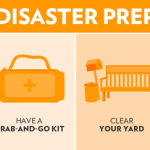By: Gwen Moran
A home inventory of your belongings for insurance purposes is a relatively inexpensive way to make any future claims go smoother.
Creating a home inventory for insurance doesn’t need to be complicated. All you really need is a pencil and paper. The key is to have a record of your possessions in the event you experience a theft or casualty loss from flood, fire, or other disaster.
But the more thorough the documentation of your belongings, the less likely you are to run into problems when you file an insurance claim. That’s why you should consider using a digital camera, fireproof safes, and other equipment to create and store your home inventory. Devote a full day to the task.
Take pictures of your belongings
Photos of your belongings go a long way toward demonstrating ownership and value. Digital photos are preferred, since they’re easier to print and store. A decent digital camera costs less than $100. Be sure to get full-room shots, as well as close-ups of items. Don’t neglect to photograph possessions inside drawers, cabinets, and closets.
Video is even more convenient and effective, especially since you can record audio along with the images. Describe items and any identifying details as you film your home room by room. Digital camcorders are available for less than $150. It’s a good idea to keep backup copies of digital files and hard-copy printouts in a safe place. (More on storage options below.)
Prepare a written home inventory
Images alone aren’t enough. You should also prepare a written home inventory. Your insurance company will likely ask for one if you ever file a claim. Include as much identifying detail as possible, such as serial numbers, brand names, purchase dates, and estimated costs. Keep a copy off-site, perhaps with a friend or in a bank safe-deposit box, in case your home is damaged or destroyed. Download our free home inventory worksheet to get started.
Home inventory software is also available. Enter information on your possessions, attach digital images, and store the data electronically. The Insurance Information Institute has a free program called Know Your Stuff, or there are a number of programs available for purchase.
Be sure to attach receipts to your home inventory list. If you’re storing your records electronically, you’ll want to scan receipts at a copy and print shop or purchase a scanner. Pick one up for as little as $50 at an office supply store. Digital copies of receipts come in handy if originals are damaged or lost.
Safe ways to store your records
When backing up digital files, a USB drive—sometimes called a “thumb” drive, due to its small size—can be useful. Buy one for as little as $5. Simply copy the files onto the drive and keep it somewhere safe, preferably away from your home.
You can also stash a drive in a pre-packed emergency “go” bag, which should be accessible in case you need to evacuate quickly. An external hard drive can perform the same function, though it’s less portable.
You can use a bank safe-deposit box to store paper records, drives, and other valuables off-premises. Rent may range from about $25 per year for a small box to more than $100 for a larger box.
If you like to keep important documents closer at hand, consider a fireproof safe, which is usually waterproof as well. You can find small safes for as little as $50, but a more representative range for good residential fireproof safes is $150 to $300. Larger, high-end safes can cost more than $1,000.
When your home inventory files are electronic, it’s relatively easy to use online backup systems to keep digital copies outside of your home. That’s a big plus if your computer is stolen or destroyed. Some backup services like Mozy offer limited storage space for free, while others like Carbonite charge $5 or more per month. Choose a backup service whose features fit your needs.



